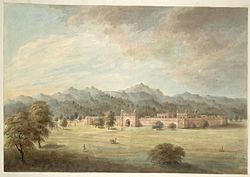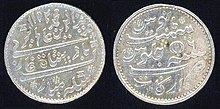
The Third Battle of Panipat took place on 14 January 1761 between the Maratha Confederacy and the invading army of the Durrani Empire. The battle took place in and around the city of Panipat, approximately 97 kilometres (60 mi) north of Delhi. The Afghans were supported by three key allies in India: Najib ad-Dawlah who persuaded the support of the Rohilla chiefs, elements of the declining Mughal Empire, and most prized the Oudh State under Shuja-ud-Daula. The Maratha army was led by Sadashivrao Bhau, who was third-highest authority of the Maratha Confederacy after the Chhatrapati and the Peshwa. The bulk of the Maratha army was stationed in the Deccan Plateau with the Peshwa.

Mirza Nasir-ud-Din Muḥammad Shah was the thirteenth Mughal emperor from 1719 to 1748. He was son of Khujista Akhtar, the fourth son of Bahadur Shah I. After being chosen by the Sayyid Brothers of Barha, he ascended the throne at the young age of 16, under their strict supervision.

Balaji Baji Rao, often referred to as Nana Saheb I, was the 8th Peshwa of the Maratha Confederacy. He was appointed as Peshwa in 1740 upon the death of his father, the Peshwa Bajirao I.

Shuja-ud-Daula was the third Nawab of Oudh and the Vizier of Delhi from 5 October 1754 to 26 January 1775.

Ahmad Shah Bahadur, also known as Mirza Ahmad Shah or Mujahid-ud-Din Ahmad Shah Ghazi, was the fourteenth Mughal emperor, born to Emperor Muhammad Shah. He succeeded his father to the throne in 1748, at the age of 22. When Ahmed Shah Bahadur came to power, the Mughal Empire started to decline. Furthermore, his administrative weakness eventually led to the rise of the usurping Imad-ul-Mulk.

Shah Alam II, also known by his birth name Ali Gohar, or Ali Gauhar, was the seventeenth Mughal emperor and the son of Alamgir II. Shah Alam II became the emperor of a crumbling Mughal Empire. His power was so depleted during his reign that it led to a saying in the Persian language, Sultanat-e-Shah Alam, Az Dilli ta Palam, meaning, 'The empire of Shah Alam is from Delhi to Palam', Palam being a suburb of Delhi.

Mir Syed Jafar Ali Khan Bahadur was a commander-in-chief or military general who reigned as the first dependent Nawab of Bengal of the British East India Company. His reign has been considered by many historians as the start of the expansion of British control of the Indian subcontinent in Indian history and a key step in the eventual British domination of vast areas of pre-partition India.

Raghunathrao , also known as Ragho Ballal or Raghoba Dada, was the younger son of Peshwa Bajirao I who served as the 11th Peshwa of the Maratha Confederacy for a brief period from 1773 to 1774.

Najib ad-Dawlah, also known as Najib Khan Yousafzai, was a Rohilla Yousafzai Afghan who earlier served as a Mughal serviceman but later deserted the cause of the Mughals and joined Ahmad Shah Abdali in 1757 in his attack on Delhi. He was also a House Chief of Rohilkhand, and in the 1740s founded the city of Najibabad in Bijnor, India. He was instrumental in winning the Third Battle of Panipat.

The Nawab of Awadh or Nawab of Oudh was the title of the rulers of Kingdom of Awadh in northern India during the 18th and 19th centuries. The Nawabs of Awadh belonged to an Iranian dynasty of Sayyid origin from Nishapur, Iran. In 1724, Nawab Sa'adat Khan established the Kingdom of Awadh with their capital in Faizabad and Lucknow.

Hafiz Rahmat Khan was the Regent of Rohilkhand in North India, from 1749 to 1774. He was a Pashtun by background, ruling over Rohillas. Hafiz Rahmat Khan had served honorably throughout the reign of three Mughal Emperors: Ahmad Shah Bahadur, Alamgir II and Shah Alam II. He was also a mentor of Prince Mirza Jawan Bakht.

Feroze Jung III or Nizam Shahabuddin Muhammad Feroz Khan Siddiqi Bayafandi also known by his sobriquet Imad-ul-Mulk, was the grand vizier of the Mughal Empire when it was under Maratha suzerainty, making them the de facto rulers.
Intizam-ud-Daula, Ghazi ud-Din Khan Siddiqi Bayafandi Feroze Jung II was the eldest son of Asaf Jah I Mir Qamaruddin Khan Siddiqi. He was born on 13 March 1709, his mother is Sa'id un-Nisa Begum, the daughter of a Sayyid nobleman at Gulbarga. He died in Aurangabad on 16 October 1752.

Shahzada Mirza Jawan Bakht Bahadur was a Mughal prince and the eldest son of Emperor Shah Alam II and the grandson of Emperor Alamgir II. He was born in 1749 at the Red Fort, Delhi. Jawan Bakht was a very influential Timurid Prince of the Mughal Empire and he also briefly served as the Heir-apparent of the Mughal Empire.

The Great Maratha is an Indian historical drama television series directed by Sanjay Khan and produced by Numero Uno International Limited. The drama aired on DD National. The series is based on the life of Mahadaji Shinde. The show comprised 47 episodes. The music was composed by Mohammed Zahur Khayyam.
The Battle of Narela took place on 16 January 1757, at Narela, on the outskirts of Delhi, between the Maratha Army led by Antaji Mankeshwar and an army of Ahmad Shah Abdali.

The Battle of Delhi in 1757 also referred to as the Second Battle of Delhi, was fought on 11 August 1757 between the Maratha Confederacy under the command of Raghunath Rao and the Rohillas under the command of Najib-ud-Daula, who was under the Afghan suzerainty and simultaneously the "Pay Master" of what remained of the Mughal Army. By 1757, Delhi was ruled indirectly by the Marathas. The battle was waged by the Marathas for the control of Delhi, the Mughal capital which was invaded by Rohilla chief Najib-ud-Daula, as a consequence of the fourth invasion of India by Ahmad Shah Abdali.
The Safdarjung's rebellion occurred on 10 March 1753 during the waning years of the Mughal Empire. It was characterized by a conflict between Safdarjung, the Nawab of Oudh, and the Mughal emperor Ahmad Shah Bahadur, alongside his court factions.

Muhammad Ahmad Khan Bahadur Ghalib Jang or Ahmad Khan Bangash was a Mughal nobleman and Nawab of Farrukhabad from the Rohilla Afghan Bangash dynasty. He was the second son of Muhammad Khan Bangash, a powerful Mughal nobleman. He took part in the Third Battle of Panipat in 1761 against the Marathas led by Sadashivrao Bhau.

The Sack of Delhi occurred from 17 January – 22 February 1757, carried out by the Durrani Empire under the Afghan King Ahmad Shah Durrani. Delhi, the capital of the Mughal Empire, experienced multiple invasions by the Afghans during the 18th century.


























